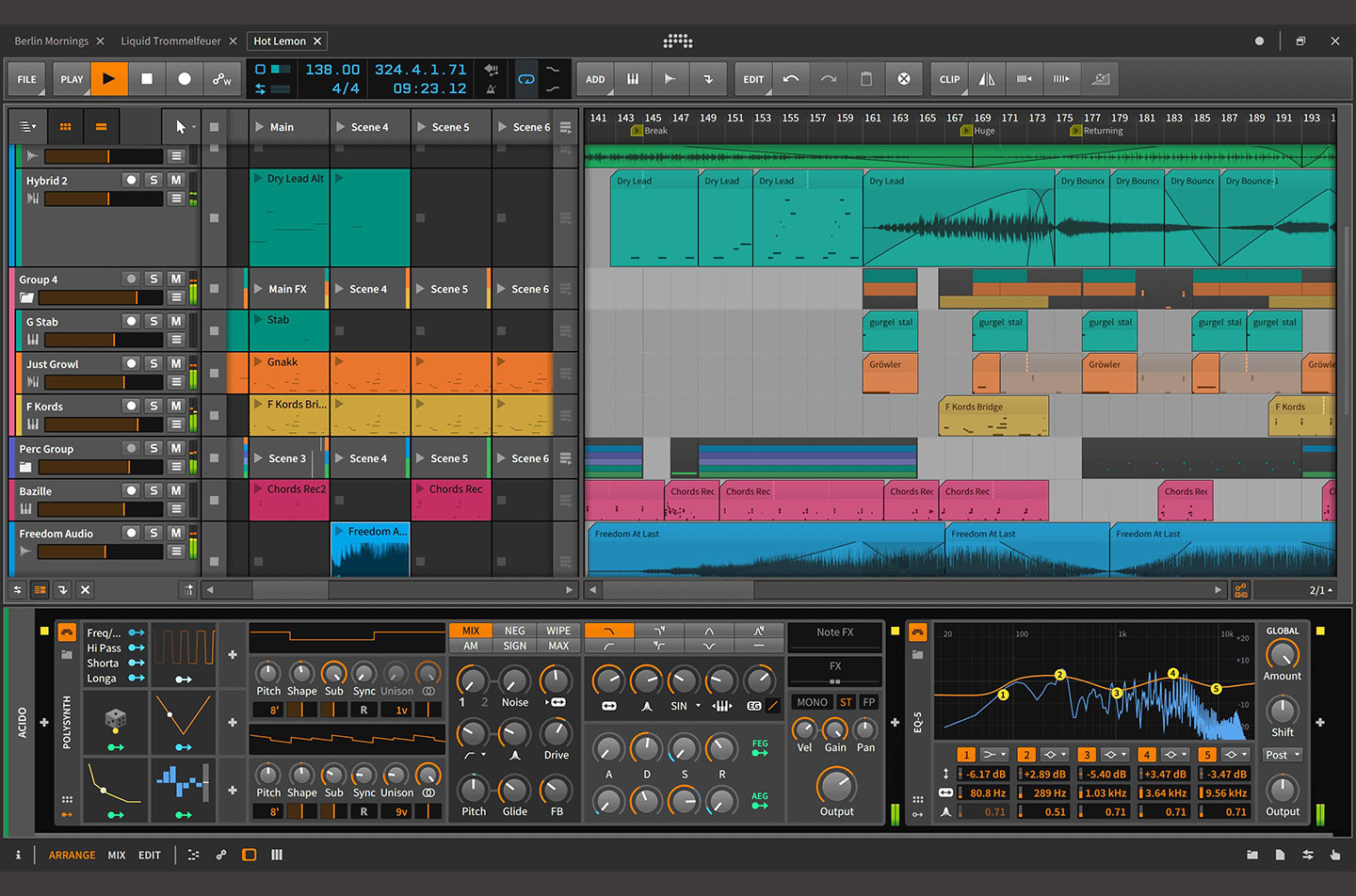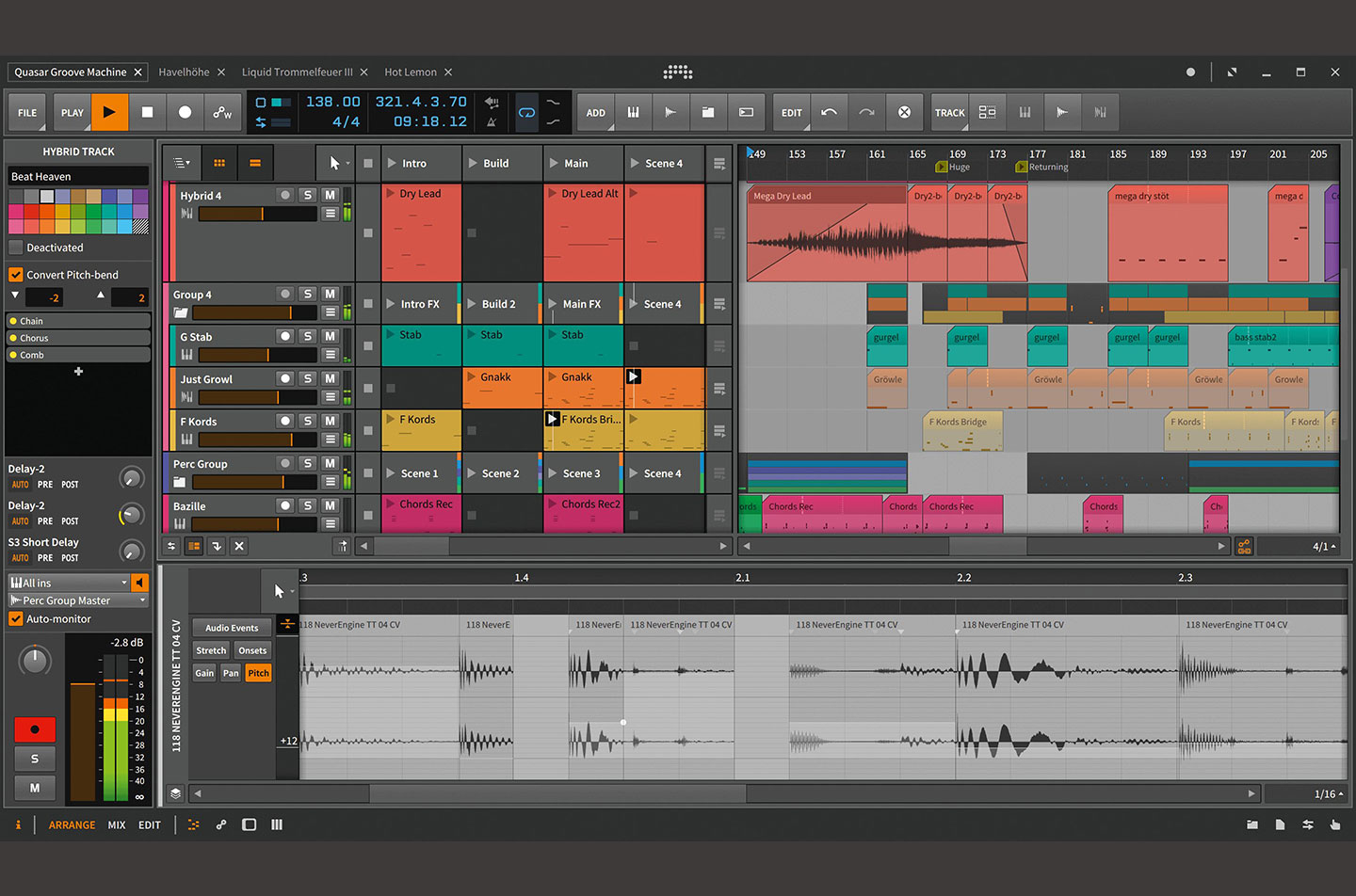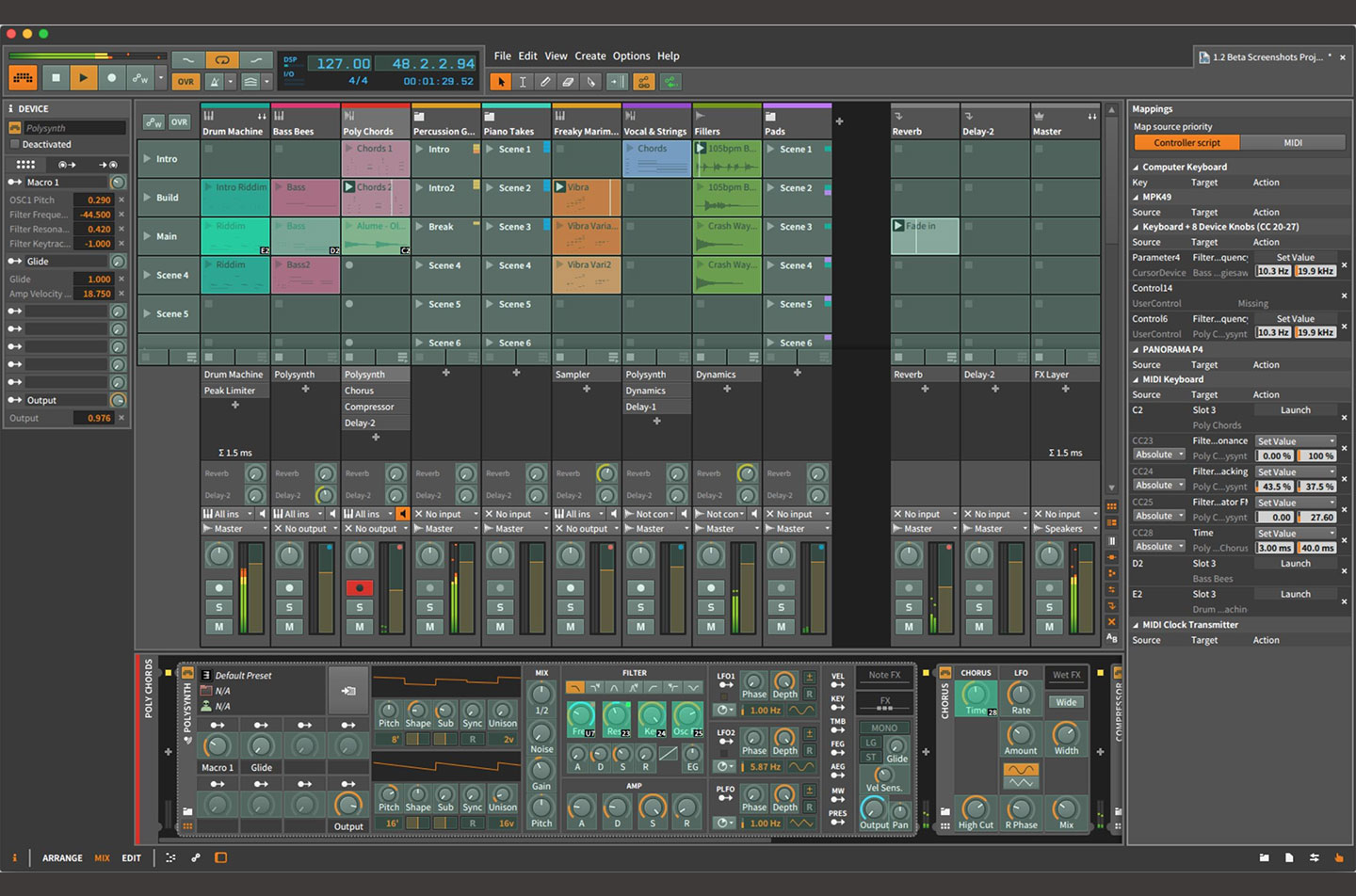- Launched in 2014, Bitwig Studio aimed to shake up the DAW market with a number of original and innovative features. There was per-note MIDI expressions, cross-platform VST sandboxing and the side-by-side clip launcher and arrangement page that has become one of the original DAW's hallmarks. However, for many, it simply wasn't revolutionary enough to coax people away from their trusted DAW—and the fact that it bore a number of fairly obvious resemblances to Ableton didn't help the situation and only provided ammo for the sceptics. Although other companies have to balance the needs of a loyal and stable customer base with a dependable release schedule, Bitwig's smaller and more focused development team has been able to quickly roll out incremental updates, bug fixes and new features as point releases. This allowed them to rapidly address early issues and adopt a number of user-requested additions, including a number of new audio and MIDI devices, the ability to group tracks and expanding its multi-touch support platforms. As such, the program has swiftly matured, and this rapid progression has made version 2.0 a more stable, cohesive and useable product, which innovates while refining its core components.
My first impressions were promising. The UI appears flatter, echoing a general move away from the skeuomorphic design language that's dominated the tech scene. However, it still feels somewhat cluttered, especially when in comparison to the sharp, pared-down aesthetic that Ableton has long been known for. A large part of this is down to the spacing between the different elements that make up the UI. I appreciate the need for padding as a means of visual differentiation but on smaller screens a lot of that space just seems wasted. Thankfully, Bitwig's modular approach extends to its layout. Once you familiarise yourself with the various keyboard shortcuts, the ability to reveal and hide the different sections of the layout quickly becomes second nature. This constant readjustment and rearrangement could be seen as a bit of a pain, especially for those coming from the all-in-one aesthetic favoured by Logic and Pro Tools. But given a little time, it's a workflow addition that forces you to focus on the task at hand, whether it's micro-editing audio samples, jamming out an arrangement or building custom device mappings.
The banner feature of this release is the expansive and comprehensive update of Bitwig's "unified modulation system." While it's not quite the "fully modular device architecture" mooted back in 2012, Studio 2 gets us considerably closer to this vision. Every device, including third-party plug-ins, now has the ability to be affected by a seemingly infinite number of new modulators (Check out Polarity's Ultra-Chord preset for a great example of how these modulators can be put to use). Each modulator can affect any number of device controls, with the specific amount of modulation being unique to each control. Macros, the previous means of modulation and automation in Bitwig, have been swallowed up by the modular system and replaced by Remote Controls, which deal exclusively in automation. Splitting up modulation and automation makes a lot of sense. Both can be used to control the same parameters if desired, leading to some interesting push and pull as the modulator's influence works within the absolute boundaries set by the automation. You also save the Remote Controls on a per-device or per-preset level.
Beyond the internal routing options offered by the modular architecture, Studio 2 has greatly expanded its ability to integrate with hardware. MIDI CC, MIDI Program Change and MIDI Song Select devices all allow direct control of external gear from within the program. Combining the MIDI CC device with the modulators effectively adds modular-style control to any hardware synth, which massively expands its capabilities. There are also new devices that exclusively deal with CV and gate information. This means that Studio 2 could become a seamless and integral part of your entire studio, rather than merely the endpoint of your signal path.
This approach also extends to dedicated MIDI controllers. Btiwig's website contains scripts for pretty much every popular controller currently on the market, including, impressively, Ableton's Push and Push 2. While the functionality when using Push is fairly (and expectedly) limited, a Bitwig-approved script by musician and developer Jürgen Moßgraber allows for the pads and display to provide Bitwig specific controls and feedback. It's not a particularly elegant solution (the UI on Push 2 is considerably more lo-res than when connected to Ableton), but providing you are comfortable copy-pasting a few lines of code, it could well be a solution for those reluctant to switch from Ableton due to their investment in Push.
The modular overhaul has meant that a number of devices, including Bitwig's flagship Polysynth, have lost some of their controls to accommodate the new, more flexible approach. A stereo width control is now built-in and available per oscillator, which in tandem with the Unison knob allows for some very wide, lush sounds. This means you can increase the stereo-width of a higher-pitched oscillator while keeping a lower, bassier oscillator in mono, for example. There's also a new drive control, dedicated high-pass filter, a post-filter waveshaper and six new oscillator blend-modes. While the FM-4 synth and sampler have received fairly minor updates, the increased functionality of Polysynth makes up for it.
Devices that probably should've been available in the original version have been added, including a phaser, spectrum analyser and ring modulator. Other preexisting devices have seen useful updates in the form of dynamic displays that help to visualise the movement and signal flow of parameters, especially useful considering the potential complexity offered by the new modulation system.
A lot of Bitwig Studio 2's smaller tweaks have been based around increasing efficiency and workflow. While Bitwig has concerned itself with rapid and aggressive growth of features over its short-lived existence, Studio 2 seeks to make those features more accessible and easier to use. The ability to apply fades and crossfades was a pretty glaring omission from Bitwig Studio 1 and it's nice to see them finally implemented and available at both clip and track levels. An option to pin almost any menu item to the menu bar is another nice touch and though the keyboard shortcuts are comprehensive (and in many cases, identical to those in Ableton) this makes it easy to keep oft-used functions close at hand, and will prove especially useful to those on touch-screen devices.
The mouse-based tools have also been updated with contextual functionality. If you highlight a section of empty space in the arrangement view, the time selection tool is automatically chosen. If you drag a clip, it will switch to the Add Object tool. One confusing decision however is to allow independent instances of these tools in both the arranger/launcher window and the edit window. It's a seemingly superfluous addition that didn't offer any workflow benefits.
Many Ableton users will sorely miss the option to adjust track delay. This is an often invaluable feature for tightening up a groove, adding subtle swing or simply amending latency errors after recording. While it's possible that Bitwig will include this in a future update, for now, DMGAudio offer a free plug-in with both forwards and backwards delay.
While the thought of switching DAWs is a stressful and tedious one (especially to those who use them daily for professional work), it's important to remember that Bitwig Studio 2 is still an incredibly young proposition. Yet, in many ways, it is already comparable to workstations whose version numbers are at, or near to, double figures. Bitwig Studio 2 addresses pretty much every shortcoming levelled at its previous version, while adding a number of impressive features not available in any other DAW. It makes you wonder where, and how quickly, they can go from here.
Ratings:
Cost: 3.9
Versatility: 4.5
Ease of use: 4.0
Sound: 4.0
 Devices that probably should've been available in the original version have been added, including a phaser, spectrum analyser and ring modulator. Other preexisting devices have seen useful updates in the form of dynamic displays that help to visualise the movement and signal flow of parameters, especially useful considering the potential complexity offered by the new modulation system. A lot of Bitwig Studio 2's smaller tweaks have been based around increasing efficiency and workflow. While Bitwig has concerned itself with rapid and aggressive growth of features over its short-lived existence, Studio 2 seeks to make those features more accessible and easier to use. The ability to apply fades and crossfades was a pretty glaring omission from Bitwig Studio 1 and it's nice to see them finally implemented and available at both clip and track levels. An option to pin almost any menu item to the menu bar is another nice touch and though the keyboard shortcuts are comprehensive (and in many cases, identical to those in Ableton) this makes it easy to keep oft-used functions close at hand, and will prove especially useful to those on touch-screen devices.
Devices that probably should've been available in the original version have been added, including a phaser, spectrum analyser and ring modulator. Other preexisting devices have seen useful updates in the form of dynamic displays that help to visualise the movement and signal flow of parameters, especially useful considering the potential complexity offered by the new modulation system. A lot of Bitwig Studio 2's smaller tweaks have been based around increasing efficiency and workflow. While Bitwig has concerned itself with rapid and aggressive growth of features over its short-lived existence, Studio 2 seeks to make those features more accessible and easier to use. The ability to apply fades and crossfades was a pretty glaring omission from Bitwig Studio 1 and it's nice to see them finally implemented and available at both clip and track levels. An option to pin almost any menu item to the menu bar is another nice touch and though the keyboard shortcuts are comprehensive (and in many cases, identical to those in Ableton) this makes it easy to keep oft-used functions close at hand, and will prove especially useful to those on touch-screen devices. The mouse-based tools have also been updated with contextual functionality. If you highlight a section of empty space in the arrangement view, the time selection tool is automatically chosen. If you drag a clip, it will switch to the Add Object tool. One confusing decision however is to allow independent instances of these tools in both the arranger/launcher window and the edit window. It's a seemingly superfluous addition that didn't offer any workflow benefits. Many Ableton users will sorely miss the option to adjust track delay. This is an often invaluable feature for tightening up a groove, adding subtle swing or simply amending latency errors after recording. While it's possible that Bitwig will include this in a future update, for now, DMGAudio offer a free plug-in with both forwards and backwards delay. While the thought of switching DAWs is a stressful and tedious one (especially to those who use them daily for professional work), it's important to remember that Bitwig Studio 2 is still an incredibly young proposition. Yet, in many ways, it is already comparable to workstations whose version numbers are at, or near to, double figures. Bitwig Studio 2 addresses pretty much every shortcoming levelled at its previous version, while adding a number of impressive features not available in any other DAW. It makes you wonder where, and how quickly, they can go from here. Ratings: Cost: 3.9 Versatility: 4.5 Ease of use: 4.0 Sound: 4.0
The mouse-based tools have also been updated with contextual functionality. If you highlight a section of empty space in the arrangement view, the time selection tool is automatically chosen. If you drag a clip, it will switch to the Add Object tool. One confusing decision however is to allow independent instances of these tools in both the arranger/launcher window and the edit window. It's a seemingly superfluous addition that didn't offer any workflow benefits. Many Ableton users will sorely miss the option to adjust track delay. This is an often invaluable feature for tightening up a groove, adding subtle swing or simply amending latency errors after recording. While it's possible that Bitwig will include this in a future update, for now, DMGAudio offer a free plug-in with both forwards and backwards delay. While the thought of switching DAWs is a stressful and tedious one (especially to those who use them daily for professional work), it's important to remember that Bitwig Studio 2 is still an incredibly young proposition. Yet, in many ways, it is already comparable to workstations whose version numbers are at, or near to, double figures. Bitwig Studio 2 addresses pretty much every shortcoming levelled at its previous version, while adding a number of impressive features not available in any other DAW. It makes you wonder where, and how quickly, they can go from here. Ratings: Cost: 3.9 Versatility: 4.5 Ease of use: 4.0 Sound: 4.0